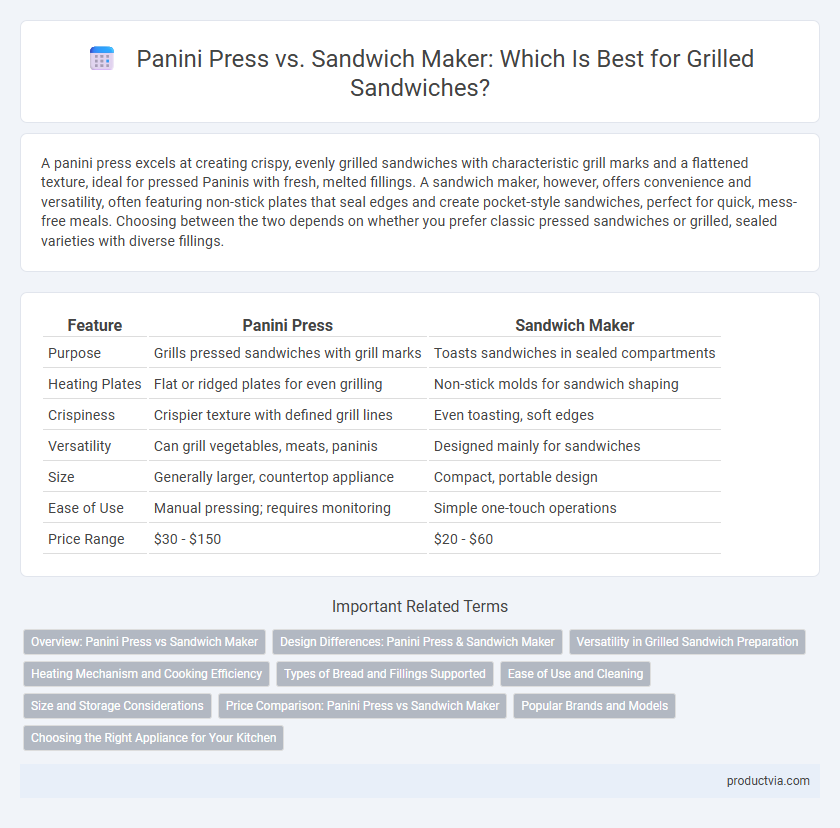A panini press excels at creating crispy, evenly grilled sandwiches with characteristic grill marks and a flattened texture, ideal for pressed Paninis with fresh, melted fillings. A sandwich maker, however, offers convenience and versatility, often featuring non-stick plates that seal edges and create pocket-style sandwiches, perfect for quick, mess-free meals. Choosing between the two depends on whether you prefer classic pressed sandwiches or grilled, sealed varieties with diverse fillings.
Table of Comparison
| Feature | Panini Press | Sandwich Maker |
|---|---|---|
| Purpose | Grills pressed sandwiches with grill marks | Toasts sandwiches in sealed compartments |
| Heating Plates | Flat or ridged plates for even grilling | Non-stick molds for sandwich shaping |
| Crispiness | Crispier texture with defined grill lines | Even toasting, soft edges |
| Versatility | Can grill vegetables, meats, paninis | Designed mainly for sandwiches |
| Size | Generally larger, countertop appliance | Compact, portable design |
| Ease of Use | Manual pressing; requires monitoring | Simple one-touch operations |
| Price Range | $30 - $150 | $20 - $60 |
Overview: Panini Press vs Sandwich Maker
A Panini press specializes in grilling sandwiches with heat applied from both the top and bottom plates, creating distinctive grill marks and a crispy texture, while a sandwich maker typically uses compact plates that seal the sandwich edges, resulting in a toasted, sealed pocket. Panini presses often allow for adjustable temperature settings and accommodate a variety of bread types, making them versatile for different grilled sandwich styles. Sandwich makers are generally designed for quick, easy preparation with consistent heat distribution, ideal for straightforward toasted sandwiches.
Design Differences: Panini Press & Sandwich Maker
Panini presses feature flat or ridged heated plates designed to press and grill sandwiches evenly, often producing characteristic grill marks on the bread. Sandwich makers typically consist of molded, clamshell designs with non-stick compartments shaped to cradle sandwich halves, sealing and toasting the contents simultaneously. The panini press allows for flexible sandwich sizes and thicknesses, whereas sandwich makers limit sandwich dimensions due to their fixed compartment shapes.
Versatility in Grilled Sandwich Preparation
A Panini press offers targeted grilling with ridged plates that create distinct grill marks and even heating for pressed sandwiches. Sandwich makers typically feature interchangeable plates or flat surfaces that accommodate various sandwich styles, from toasted to sealed crusts, enhancing versatility. For diverse grilled sandwich preparation, sandwich makers provide broader functionality, while Panini presses excel in specialized, crisp panini results.
Heating Mechanism and Cooking Efficiency
Panini presses utilize heated ridged plates that apply direct, even pressure and heat, ensuring grill marks and faster cooking times, while sandwich makers often rely on non-ridged plates with lower pressure, resulting in slower, less uniform heating. The heating mechanism in panini presses typically includes adjustable temperature controls and stronger heating elements, enhancing cooking efficiency for thicker sandwiches. In contrast, sandwich makers may have simpler heating elements designed primarily for basic toasting, which can lead to unevenly cooked fillings and less browning on the bread.
Types of Bread and Fillings Supported
Panini presses feature ridged plates that create grill marks and are ideal for ciabatta, focaccia, and other sturdy Italian breads, supporting hearty fillings like mozzarella, cured meats, and roasted vegetables. Sandwich makers often have flat or slightly grooved surfaces suited for softer breads such as white, whole wheat, or sandwich loaves, accommodating classic fillings like ham, cheese, and peanut butter. Bread thickness and filling moisture influence the choice; panini presses handle thick, dense bread with melted cheese or marinated ingredients, while sandwich makers excel at evenly toasting thinner, delicate sandwich combinations.
Ease of Use and Cleaning
Panini presses often feature adjustable temperature controls and non-stick plates that provide precise grilling, making them user-friendly for achieving perfect sandwiches. Sandwich makers typically offer straightforward operation with simple flip or close mechanisms, ideal for quick use with minimal adjustments required. Cleaning panini presses can be easier due to removable plates, while many sandwich makers have fixed plates that need careful wiping to avoid residue buildup.
Size and Storage Considerations
Panini presses often have a larger footprint due to their robust build and floating hinge mechanism, making them less ideal for compact kitchens compared to sandwich makers. Sandwich makers typically feature a more compact design with vertical storage capability, optimizing countertop and cabinet space. When selecting between the two, consider available kitchen space and ease of storage to maintain a clutter-free environment.
Price Comparison: Panini Press vs Sandwich Maker
Panini presses typically range from $30 to $150, offering adjustable temperature settings and heavy-duty plates for consistent grilling, while sandwich makers usually cost between $20 and $80, providing simpler designs suited for basic sandwiches. The higher price of a panini press reflects its versatility and ability to create restaurant-quality grilled sandwiches with even heat distribution. Buyers seeking budget-friendly options often prefer sandwich makers, though they may sacrifice advanced features and precise grilling control found in panini presses.
Popular Brands and Models
Top Panini press models like the Breville Prisma and Cuisinart GR-4N offer versatile grilling plates and adjustable temperature controls, ideal for perfectly pressed sandwiches. Leading sandwich makers such as the Hamilton Beach 25460 and Philips Daily Collection prioritize compact designs with non-stick plates for easy cleanup and consistent grilling performance. Consumer ratings highlight the balanced heating and durability of Breville and Hamilton Beach as key factors in their popularity for grilled sandwich preparation.
Choosing the Right Appliance for Your Kitchen
A panini press is specially designed for pressing and grilling sandwiches with grill marks, offering even heat distribution that crisps bread while melting fillings perfectly. A sandwich maker typically uses heated plates to press sandwiches closed, making it ideal for simpler, toasted sandwich recipes without needing the ridged grill effect. Choosing the right appliance depends on your preference for sandwich texture, cooking style, and the versatility required in your kitchen appliances.
Panini press vs Sandwich maker for grilled sandwiches Infographic

 productvia.com
productvia.com